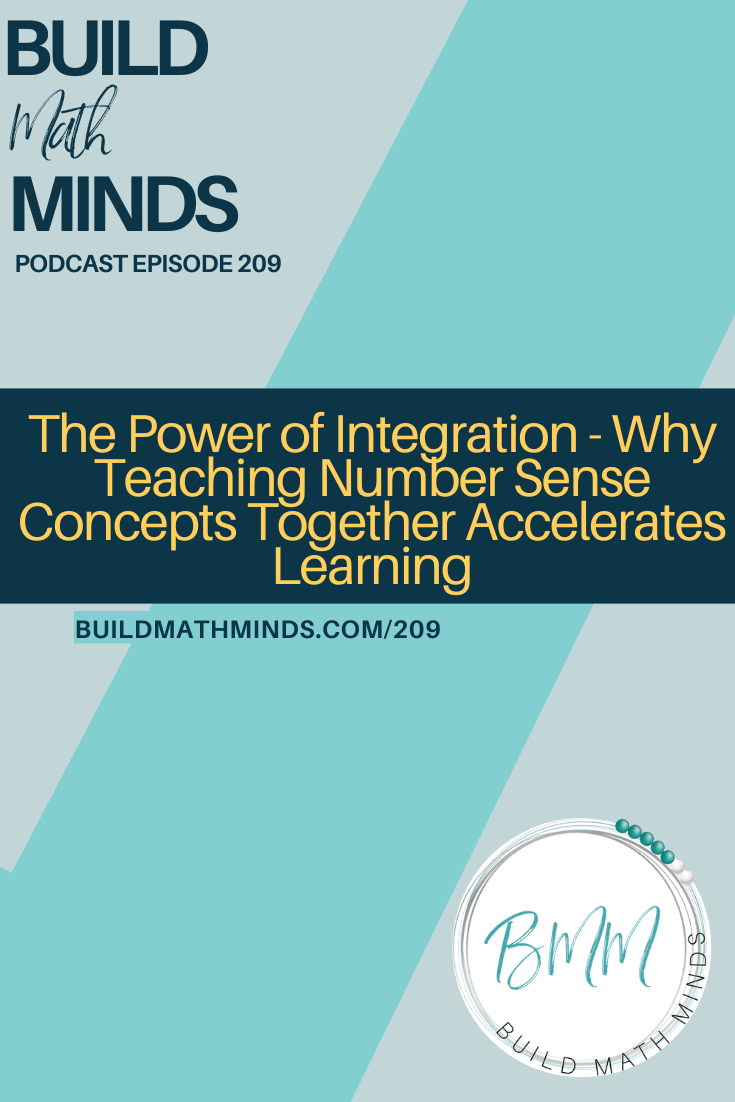Welcome fellow Recovering Traditionalists to Episode 209: The Power of Integration – Why Teaching Number Sense Concepts Together Accelerates Learning
Over the past two episodes, we’ve covered the 8 foundational number sense concepts – the 4 early numeracy foundations and the 4 number relationships. And I promised you I’d share one of my favorite practical tools for building all of these concepts. But before I do that, I need to address what I know many of you are thinking right now.
You’re sitting there thinking, “Christina, this all sounds great. I get that these 8 concepts are important. But I already don’t have enough time to teach everything I’m required to teach. How am I supposed to add 8 MORE things to my already overflowing plate?”
And if you’re feeling that way, I don’t blame you.You feel like you need to do subitizing activities, AND counting activities, AND spatial relationship work, AND part-part-whole activities, AND benchmark activities…”
But here’s what I learned:
You don’t need 8 separate activities. You don’t need 8 separate time slots. You don’t need to “check off” one concept at a time.
The magic of number sense doesn’t happen when you isolate these concepts. It happens when you weave them together.
Because here’s the truth: these 8 concepts aren’t meant to be taught in isolation. They’re interconnected. They build on each other. They reinforce each other.
WHY INTEGRATION MATTERS
Think about it this way. You can’t truly develop part-part-whole thinking without students understanding benchmarks. If a student doesn’t know that 10 is a friendly benchmark number, they’re not going to think about breaking 8+5 into 8+2+3 to make a ten.
You can’t develop sophisticated spatial relationships without subitizing. If students can’t instantly recognize small quantities, they won’t be able to visualize larger quantities as composed of smaller groups.
You can’t use the one/two more or less relationship strategically if you don’t have strong verbal counting patterns.
So there is somewhat an order to these concepts, but when we try to teach these concepts one at a time, in isolation, we’re actually making it HARDER for students.
We’re breaking apart something that should be whole. But let me just say, it isn’t your fault…we’ve been trained to think this way. Math has always been a series of isolated skills that we teach independent of each other. When I was teaching 6th grade I remember my textbook having a chapter on decimals, later a chapter on fractions, and then even later a chapter on percentages. These should all be connected together!
THE TRADITIONAL APPROACH VS. THE EFFECTIVE APPROACH
The traditional approach would have you spend two weeks on subitizing. Then move to counting activities for a couple weeks. Then do Spatial Relationships, then one/two more and less…
Can you see the problem? By the time you eventually get to benchmarks, the subitizing work is in the rearview mirror. Students aren’t seeing the connections.
For a more effective approach think like this: Every activity should touch multiple concepts and you need to help students see how those ideas connect.
This is not only more effective for student learning, it’s also the answer to your time problem. When one 10-minute activity builds 5 or 6 concepts simultaneously, you’re not adding time – you’re using your time more strategically.
AN EXAMPLE ACTIVITY
So let me share with you the practical tool I promised in a previous episode- one of my absolute favorite ways to integrate multiple number sense concepts in one activity. It’s Number Strings.
Now, hopefully you’ve heard of Number Strings before, if not I’ll link up some resources in the show notes (BuildMathMinds.com/209). Maybe you’ve even tried Number Strings. But what I find is that many teachers use Number Strings without realizing just how powerful they are for building these foundational concepts.
The power of a Number String is that it’s a sequence of related problems that helps students see patterns and relationships between numbers. You present problems one at a time, students solve them mentally, and you record their strategies. The key is that problems in the string are connected in some way, helping students use what they know to figure out what they don’t know.
But here’s what makes Number Strings so powerful for our purposes: when done well, a single Number String can simultaneously develop subitizing, spatial relationships, benchmarks, part-part-whole thinking, and one/two more or less relationships. All in 10 minutes or less.
Let me show you what I mean.
EXAMPLE 1: EARLY ELEMENTARY NUMBER STRING
Let’s say you’re working with first or second graders. Here’s a simple Number String focused on making ten:
Problem 1: 5 + 5
You’d show this problem, give students a moment to think, then ask for the answer and how they figured it out. Most students will know this pretty quickly – it might be a subitized pattern they recognize, or they might use their fingers to see two groups of 5.
Problem 2: 6 + 4
Now, some students might count. But watch what happens when you record a student’s strategy who thought: “That’s just like having 5+5 but 6 is one more than 5, so it’s like you took from the 5 on the other side. That’s 4.”
Can you see what’s happening? They’re using:
- Part-part-whole: breaking numbers into apart
- Benchmarks: using 10 as a reference point
- One more/one less: understanding how 6 relates to 5 and how 4 relates to 5
- Spatial relationships: if they visualized it, they might be seeing 5 and 1 more or to help with that visualization you can even use visuals like these Savvy Subitizing Cards.
Problem 3: 6 + 5
Again, students can build on the previous problems. “If 6+4 is 10, then 6 + 5 must be just one more.” Or they might use the original 5 + 5.
Problem 4: 5 + 7
For this one students might see the relationship to 6+5 or they might go back to the original 5+5. It doesn’t matter, we just want them seeing relationships to any of the previous problems because it gives us a chance to talk about the relationships they are seeing to help other students see them as well.
Problem 5: 8 + 7
Now you’re extending the thinking. Some students might count. Some might see this differently, but if you use images (like 8 and 7 shown using fingers or in a ten frame) instead of just the numbers you are more likely to get students who see “5 + 5 is 10 and you have 3 and 2 left over which is 5 so that makes 15.”
Can you see how much is happening here? In one Number String, students are developing:
- Subitizing: recognizing quantities quickly
- Cardinality: understanding these quantities as a set
- Part-part-whole: decomposing and recomposing numbers
- Benchmarks of 5 and 10: using benchmarks to make the problem easier
- One/two more or less: seeing the relationships between numbers in the problem
- Spatial relationships: visualizing quantities and how they relate
- Verbal & Object Counting: you will have students who are still in the counting phase as having the visual representations of the quantities allows them to count if needed but also helps them see some of these relationships that other students are using.
EXAMPLE 2: UPPER ELEMENTARY NUMBER STRING
Now let me show you how this works with older students. Let’s say you’re working with 4th or 5th graders on multi-digit multiplication yet you also know many of them still don’t know their multiplication facts. You start out with something you HOPE they know, but might be review for some.
Problem 1: 4 × 5
Students should know this pretty quickly. Some might skip count, others might know it from memory. You record: 20.
Problem 2: 8 × 5
Now, you’re hoping someone says, “That’s just double 4×5, so it’s 40.”
When you record this strategy, you write: 8 × 5 = (4 × 5) + (4 × 5) = 20 + 20 = 40
Look what you’re building:
- Part-part-whole: 8 can be thought of as 4 + 4
- Or One/Two More and Less: this doubling to me can also be students seeing 5×4=20 as a group that they are doing one more of.
- Spatial relationships: visualizing 8 groups as two sets of 4 groups
- Benchmarks: using 5 as a friendly number to multiply with
Problem 3: 16 × 5
If students saw the pattern in the previous problem, someone might say, “That’s just double 8×5, so it’s 80.”
Or they might think about it as (10 × 5) + (6 × 5).
Either way, you’re recording their thinking and talking about the relationships they saw and how that one problem can be seen in these different ways…it’s all about the relationships between the numbers.
Problem 4: 16 x 10
Students might just try to use the ‘trick’ of just add a zero, but I’d ask them how they can prove that and hopefully we would get some kids who see the doubling that’s happening again. 16 x 10 is 16×5 doubled.
Problem 5: 16 × 20
Students might have other ways to think about this but the string we created will lead some students to see that we have once again doubled one of the factors, thus our product should be double.
Every single one of the strategies is showing sophisticated number sense. And in this one Number String, you’ve built:
- Subitizing: seeing groups within groups through the visuals we provide
- Part-part-whole: decomposing factors strategically
- Benchmarks: using 5 & 10
- One/two more or less: relating problems to each other by taking ONE MORE of the original problem
- Spatial relationships: using the visuals to compare quantities between the problems.
- Verbal & Object Counting: you will have students who are still in the counting phase even when doing Multiplication. Just like in the early grades, having the visual representations of the quantities allows them to count if needed but also helps them see some of these relationships that other students are using.
THE KEY INSIGHT
Here’s what I want you to understand: these number sense concepts don’t live in separate boxes in our students’ brains. When we teach them separately, we’re creating artificial divisions that don’t actually exist in mathematical thinking.
Flexible thinking happens when students can fluidly move between these concepts. When they can subitize a quantity, think about it spatially, decompose it using part-part-whole thinking, relate it to a benchmark, and adjust up or down – all within the same problem.
That’s what we’re building toward. And activities like Number Strings help us get there because they integrate all these concepts naturally.
Now, I need to be honest with you about something. Number Strings are incredibly powerful, but – and this is important – they only work when you know what you’re looking for and how to pull out the relationships that matter.
You have to know which of the 8 concepts you’re trying to develop. You have to be able to recognize when students are using spatial relationships versus benchmarks versus part-part-whole thinking. You have to know how to design or choose a string that targets the specific concepts your students need to develop.
And here’s what I see happen all the time: teachers try Number Strings, but because they don’t have a clear roadmap of these foundational concepts, they miss opportunities. They don’t know which student responses to highlight. They don’t know how to sequence the problems to build specific relationships. They don’t know how to connect what’s happening in the Number String to the other math work students are doing.
It’s like having a powerful tool but not knowing how to use it effectively.
This is why having a roadmap – a clear, systematic approach to building these 8 concepts – is so essential. When you know what you’re building and how these concepts connect, suddenly everything you do becomes more intentional and more effective.
YOUR PRACTICAL TAKEAWAY
So here’s what I want you to do this week: Try one Number String with your students.
If you teach early elementary, use that making-ten string I shared, or create a similar one around a different benchmark number.
If you teach upper elementary, try a multiplication string like the one I showed you, or adapt it to whatever operation you’re working on.
Or check out NumberStrings.com
But here’s the key: As you’re doing it, pay attention. Notice which of the 8 concepts naturally show up in students’ strategies. Notice which concepts your students are strong in and which ones they’re still developing.
Because that awareness – knowing what you’re looking for and being able to recognize it – that’s the foundation of being able to intentionally build number sense.
And if you’re thinking, “Christina, I need more help with this. I want to know exactly what to look for and how to design these activities systematically,” stay tuned. I’m going to be sharing something in the next episode that’s going to help you with exactly that.
In the next episode in this series, I’m going to share why most teachers’ number sense efforts fail – and it has nothing to do with the activities themselves. I’ll show you the exact mistakes that keep students stuck in counting mode. So if you’ve been doing activities like Number Strings but you feel like your students aren’t progressing the next episode is just what you need.
Until next week, my fellow Recovering Traditionalists, keep letting your students explore math, keep questioning, and most importantly, keep Building Math Minds.




